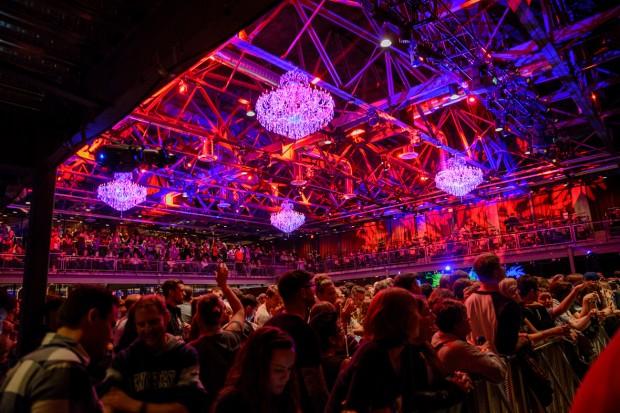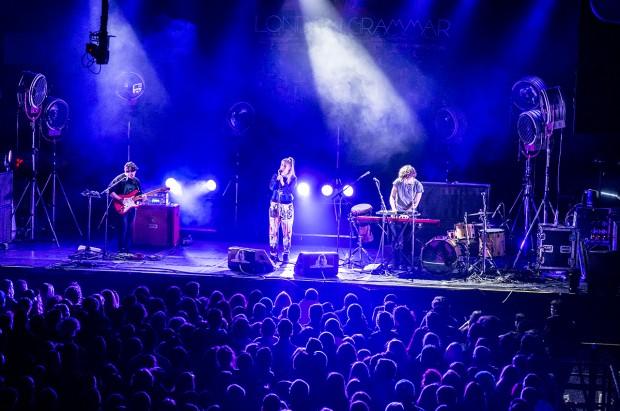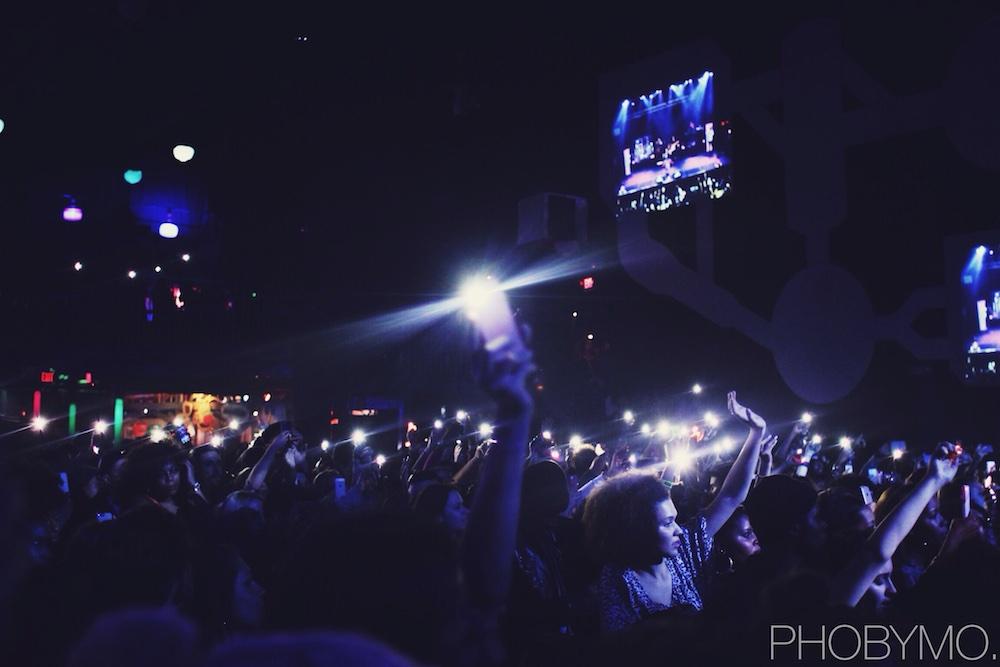
The Fillmore Philly | Photo by Kate McCann for WXPN | katemccannphotography.com
Finding The Fillmore’s place in the Philadelphia concert landscape
Last Thursday marked the official opening of Fillmore Philly, the seventh Fillmore in the LiveNation portfolio, with a sold-out Hall & Oates performance. Tickets were $95. Back in the mid-‘60s, when Bill Graham opened Fillmore West in San Francisco, tickets could go for $3. You could see Sly and the Family Stone, Jefferson Airplane, Jimi Hendrix and Led Zeppelin, essentially a dollar a band on some nights. Well, that was then and this is now – fast forward 50 years later and Disclosure is set to fill the 2,500-capacity main room two nights in a row (10/19-20) for $40 a night.
Their first 40 shows booked, between here and 2016, are as diverse as humanly possible: last Friday, WXPN welcomed Frank Turner & The Sleeping Souls and their grand, brash and baroque British rock; this weekend, Adventure Club headlines with bliss-kissed EDM and Brandi Carlile brings her delicious countrified Americana on the 11th. Tove Lo’s brand of playful but substantial pop will see her Queen of the Clouds tour consume Philly on the 17th; and before the month’s over, the main room’ll host moe. and the Cold War Kids. Quite a mix, no? And that doesn’t even broach the 450-capacity Foundry upstairs, where tickets will rarely rise above $20, and lots of smaller, local acts will get gigs.
“We really want to be the venue that can work for any type of artist,” says Ben Weeden, a California-based booking overseer for LiveNation. “We have the best production, the best sight lines, the best band experience.” Weeden is coaching and encouraging talent buyers based out of the Frankford Avenue baby, but clearly he’s been around the block and I wanted to ask him about what the future held for this particular room.

Frank Turner fans flocked to The Fillmore on its second night | Photo by Michelle Montgomery | michellemontgomeryphotography.com
“Once we get up and running, it’s going to be one of the best venues in America – this place is gorgeous. You gotta really try to do all types of music. Our thing is unity and diversity. The House of Blues mission statement is to be as diverse as possible,” says Weeden. House of Blues was gobbled up by LiveNation almost 20 years ago, but as Weeden will have you believe, the HoB spirit is still alive in the seven American Fillmores, which tend to move into and completely reinvent spaces in old buildings.
“We wanted to open the venue and make a statement but we also wanted it to be relevant to Philadelphia, which has a ton of rich musical history and Hall & Oates are a part of that rich fabric,” said Weeden. “We want to fill the room with the best shows and establish the venue right out of the gate, which I think we’ve done.”
For some, the elephant in the room is that Philadelphia’s getting to near-saturation rate for concert-goers. Independent bookers like R5 Productions may not be too pressed about the Fillmore. They book rooms like Union Transfer, the First Unitarian Church, Boot & Saddle, and a few more. R5 & Co. probably aren’t trying to box out the big boys with talent buying. But there’s no question that the Electric Factory, booked exclusively by Bonfire Shows since 2010, is gazing to their northeast with a mix of fear and wonder. Bonfire buys for Underground Arts, Ardmore Music Hall, MilkBoy and a few others, too. AEG’s likely looking at Canal St. with squinty eyes, too – the national promoter books the Mann Center, The Troc, The Keswick and some other smaller rooms. It wouldn’t be surprising if AEG and Bonfire have a LiveNation dartboard in their offices.

London Grammar devotees pack the Electric Factory | photo by Matt Shaver | mattshaverphoto.com
Of course, there’s also World Café Live and Johnny Brenda’s, whose smaller room markets are getting affected by the Fillmore’s Foundry. Drawing the connection between them all, it’s unclear how the Fillmore’s talent-buying will affect some of Philly’s smaller, more independent rooms. But there’s one thing that’s clear both from Weeden’s perspective at LiveNation and Bryan Dilworth from Bonfire’s perspective: live music in Philly is a business. It’s no kumbaya, hand-holding exercise in celebrating the culture of leisurely show-going. It’s a competition.
“The goal is, like in baseball, to hit a homerun every time. It’s certainly what I’ve learned in the 30 years of doing this – it’s a marathon and not a sprint,” says Dilworth, who just saw a celebration of 20 years of its second incarnation (the brothers Spivak, Herbert, Jerry and Allen originally founded it in 1968). “It’s like waiting tables. If you took every table and attached an emotional experience to it, you’d have a nervous fucking breakdown. It’s such a rarity that any business is able to stay alive and successful in any arena, let alone the music business. We could not be more proud of what we’ve been able to accomplish.”
When asked about the Fillmore’s opening and its effect on Bonfire’s ability to fill the Factory, he simply said “no comment.”
“No talent buyer wants to lose a show. Everybody’s always looking at other people’s calendars. That’s just part of the business,” said Weeden. He notes that there’s way more risk in buying and booking rooms in New York than there is in Philly (“You have one bad show and you lose a LOT of money,” he said). Obviously, now that the Fillmore’s up and running, they’ve cornered a large part of the market with a vertical setup that can accommodate nearly every size act (plus, y’know, marketing might). “We’re very well-integrated vertically,” he said, but they still have to do a lot of math to figure out how to buy a band. “If you only sell one ticket you still have to pay the artist the full amount. It’s a math exercise combined with dealing with strong relationships and dealing with competition,” Weeden admits.
“Certain people really love certain venues and certain people don’t care about who’s going to pay them most,” said Dilworth. “I’ll be honest with you, most of the time it comes down to money. There’s a very short window of making this kind of money for bands.” That said, he says he’s had bands turn down “immense” amounts of money for unexplained reasons. Often times, bands have their own agent doing their bidding and for them, “it’s their business, it’s their job” adds Dilworth.

Jhene Aiko fans light up the Electric Factory | Photo by Morgan Smith | phobymo.com
The Factory’s got a very strong October and November on the horizon, too: last Friday saw a sold-out Kraftwerk show at nearly $70 a ticket; Franz Ferdinand and Sparks (!) played the following night; next week it’s Danzig; much-lauded emcee and futuristic hip-hop phenom Chance the Rapper’s on the 22nd; plus November brings local heroes The Districts, Marina and the Diamonds (sold out!), Gwar, Minus the Bear and the highly-controversial but still-somehow beloved Azealia Banks.
They may be competing for some of the same talent, but as Dilworth puts it, you never know what you’re gonna get from an artist’s demands. The market also determines where he/she/they will end up based on anticipated ticket sales, previous performances or track records of sales. LiveNation may have the power of deeper pockets and a vertical advantage, but many artists see the Factory as a more storied, much-loved and scrappy-spirited room to perform.
Either way, a little competition may be just what the doctor ordered if no artist goes unpurchased.